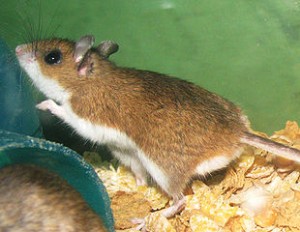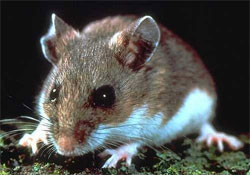Wild Animal Management MN | Deer Mice Removal
The Deer Mouse (Peromyscus maniculatus) is a misleadingly cute animal, with big eyes and ears. Its head and body measure approximately 2-3 inches (5cm – 7.5cm) in length, and the tail adds another 2 – 3 inches. They have large beady eyes and large ears giving them good sight and hearing. Their soft fur can vary in color, from white to black, but all deer mice have a distinguishable white underside and white feet.
In color, the deer mouse ranges from grey to reddish brown, depending on age. The underbelly is always white and the tail has clearly defined white sides. The hantavirus strain present in deer mice is Sin Nombre(SNV). The deer mouse is found throughout North America, preferring woodlands, but also appearing in desert areas.  View a map showing where deer mice live in North America
View a map showing where deer mice live in North America
They are also accomplished jumpers and runners by comparison to house mice, and their common name of “deer mouse” (coined 1833) is in reference to this agility. This little, agile mouse climbs well, much like a squirrel, can swim and may look for food in shallow water.
Deer mice do not hibernate. Their winter activities may include taking up quarters in a pile of logs, from which they venture nightly in search of food. Deer mice can also be found active on top of snow or beneath logs during the winter season.
Deer mice prefer the outdoors where they nest in tree holes, hollow logs, under logs and in piles of stones, branches or logs, but don’t think they stay there. If inside, they also move around in areas of a home where the least human activity occurs, such as attics, garages, basements and crawl spaces.
 Deer mice breed in every month of the year, with peaks in the periods from January through April and from June through November. Litters seem to be born in rapid succession — one captive female produced 11 litters with 42 young in a year. The gestation period varies from 22 to 27 days, averaging about 24 days. Litter size ranges from one to nine, averaging about four.
Deer mice breed in every month of the year, with peaks in the periods from January through April and from June through November. Litters seem to be born in rapid succession — one captive female produced 11 litters with 42 young in a year. The gestation period varies from 22 to 27 days, averaging about 24 days. Litter size ranges from one to nine, averaging about four.
These mice are often abundant in favorable habitats and then, as with other animals that overpopulate an area, they may become troublesome. Because of their tolerance to a wide variety of habitat conditions and their often large population they are difficult to control.
The Not-So-Innocent Deer Mouse… Cute But Deadly!
Many homeowners find it hard to believe that such a tiny critter is capable of being a danger to them and their home. But the reality is that despite their size and cute appearance, deer mice are a dangerous pest and a pose a threat to your family.
Deer mice may appear cuddly and harmless, but despite their cute little whiskers and fuzzy little bodies, the deer mouse can be extremely deadly as vectors of some serious diseases. Yup! This cute, little mouse has the dubious distinction of being the carrier of a deadly variety of Hantavirus, which causes severe pneumonia-like symptoms and is deadly in 50% of human cases where the virus gets into the lungs.
Hantavirus
The deer mouse came to the attention of the public when it was discovered to be the primary reservoir species for deer mice hantavirus.
The Hantavirus can be contracted in a number of ways: by handling dead, infected deer mouse carcasses; by breathing in mouse-urine-laden dust particles that contain the virus; or by inhaling dust from areas of accumulated deer mouse droppings. You should avoid any area where infected deer mice have frequented unless wearing proper protective gear.
Lyme Disease
A recent study in British Columbia, of 218 Deer mice showed that 30% (66) were seropositive for B. burgdorferi, the agent of Lyme disease.
Other Diseases
Ehrlichiosis and babesiosis are also carried by the deer mouse.
Prevention
Avoid exposure to urine and droppings.
- When hiking and camping, pitch tents in areas where there are no rodent droppings.
- Avoid rodent dens.
- Drink disinfected water.
- Sleep on a ground cover and pad.
- Keep your home clean. Clear out potential nesting sites and clean your kitchen.
If you must work in an area where contact with rodent urine or feces is possible, follow these recommendations from the Centers for Disease Control and Prevention (CDC):
- When opening an unused cabin, shed, or other building, open all the doors and windows, leave the building, and allow the space to air out for 30 minutes.
- Return to the building and spray the surfaces, carpet, and other areas with a disinfectant. Leave the building for another 30 minutes.
- Spray mouse nests and droppings with a 10% solution of chlorine bleach or similar disinfectant. Allow it to sit for 30 minutes. Using rubber gloves, place the materials in plastic bags. Seal the bags and throw them in the trash or an incinerator. Dispose of gloves and cleaning materials in the same way.
- Wash all potentially contaminated hard surfaces with a bleach or disinfectant solution. Avoid vacuuming until the area has been thoroughly decontaminated. Then, vacuum the first few times with enough ventilation. Surgical masks may provide some protection.
If you have done everything you can and still have deer mice infestation in your home, don’t wait! Call a Minnesota Wild Animal Management Expert today to come out and inspect your home. They can identify what type of mice, deer mice, or other rodents you may have, eliminate and sanitize any infestation, and take preventative steps to ensure your home is pest free. They will also be able to make any necessary repairs for the damage they may have caused.





